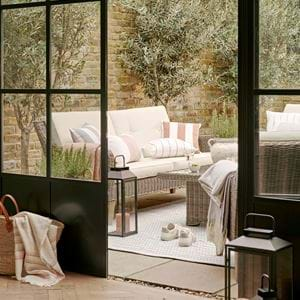How to make a spring bulb arrangement
How to make a spring bulb arrangement
Cut flowers are stunning (we’ll always have a place in our home for our life-like ones) and house plants are an essential year-round, but in spring, the season of fresh, alive new growth, our favourite way to decorate our homes with plants is with potted bulb arrangements. For our spring photoshoot, we partnered with Bath-based florists, Flowers by Passion, to create just such an arrangement that’s super simple to copy at home. Find the full step by step below, as well as a few more ideas, and head to our Instagram for the video.
A spring woodland bowl, step by step
You’ll need:
A large-ish bowl (we’ve used our new Olney large serving bowl in Burnt Sienna for our coffee table shot, and the Broseley footed bowl on the dining table)
- Gravel
- Peat-free compost
- A selection of small plants and bulbs (keep reading for our suggestions)
- Moss (we’ve used cushion moss, which you can pick up from terrarium stores)
What to do:
1. Begin by adding a layer of gravel to the bottom of your bowl. This arrangement is designed as a temporary seasonal one to last for a few weeks (when you can re-plant everything into individual pots or into the garden) so waterlogging shouldn’t be a problem, but the gravel just helps a bit with drainage.
2. Take your plants and arrange them on top of the gravel. For ours, we’ve used miniature daffodils, white hyacinths, aconites and baby ferns but you can play around with what you include. An all-white arrangement with lily of the valley would look beautifully delicate, or you could introduce purples with crocuses and, later in the season, bluebells. Just make sure to choose bulbs that have already got green shoots.
3. Once you have them positioned, fill in around the plants with compost (you can use a small trowel or just your hands). Press it down around them so everything’s held in place.
4. Finish your arrangement by tucking the moss around your plants on top of the compost. Try and cover all of the compost to create a lush green carpet.
Looking after your arrangement:
It’s important to keep your plants moist but not sitting in water, and we’ve found that a daily mist is the best way to do that, although you may also want to lightly water them if the soil feels dry. The moss will help with retaining moisture if you keep it damp.
Once the flowers on the bulbs start to go over, make sure to snip them off but don’t remove the leaves for now. Not only does this look tidier, but it’ll stop the plant from setting seed and, instead, the leaves will put all their energy back into the bulb. You can then plant them out in the garden or into pots (plant the bulbs deeper this time) and they’ll re-flower next year. The ferns will be happy planted up into their own pots, and you can reuse the moss on other indoor planters like terrariums or orchids.
Some more ideas
If you’re using your large bowl arrangement as a centrepiece on a table, be it a coffee or dining table, we think it’s nice to create smaller versions to dot around it – satellite arrangements, if you will – or to echo it elsewhere in the room.
Taking just one small plant or bulb for each one, plant them into handmade terracotta pots, tealight holders or glass tumblers. You could also gather together a larger group of these individual pots to create one long, en masse display along a mantlepiece. And they don’t all need to be planted either – add in a few bud vases with cut daffodils in them to the mix, and arrange a handful of our Lady Fern stems in a taller pot to add more height.









